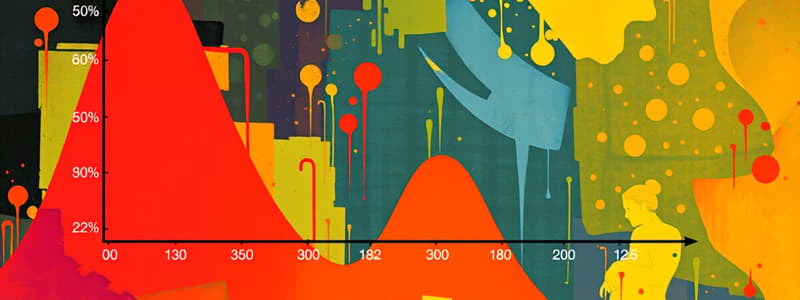Podcast
Questions and Answers
What is the conclusion statement for the 90% confidence interval comparing underclassmen to upperclassmen?
What is the conclusion statement for the 90% confidence interval comparing underclassmen to upperclassmen?
We are 95% confident that the population mean hours of sleep for underclassmen is between 0.015 more to 0.9153 more than that of upperclassmen.
In a two-sample t confidence interval, you are estimating:
In a two-sample t confidence interval, you are estimating:
- The difference in two population means (correct)
- The two individual population means
- The difference in the population proportions
- The difference in two sample means
- The two individual population proportions
If one or both samples have a sample size less than 30, you can still conduct a two-sample t test if:
If one or both samples have a sample size less than 30, you can still conduct a two-sample t test if:
- The sample means are equal
- The box plots of the samples show no outliers (correct)
- The histograms are right skewed
- The sample means have a ratio less than 2
- You have equal variances
How should we write the alternative hypothesis for the situation regarding donations?
How should we write the alternative hypothesis for the situation regarding donations?
Which statement best describes the relationship between the sample statistic and the population parameter?
Which statement best describes the relationship between the sample statistic and the population parameter?
What is the correct conclusion when you have a p-value of 0.007 and an alpha of 0.01?
What is the correct conclusion when you have a p-value of 0.007 and an alpha of 0.01?
What type of effect would an effect size of 0.2 indicate?
What type of effect would an effect size of 0.2 indicate?
What is the correct alternative hypothesis for a One way ANOVA test?
What is the correct alternative hypothesis for a One way ANOVA test?
If the family wise error rate is 0.05 and there are ten levels of one factor but only 2 comparisons are of importance, what would the individual error rate need to be?
If the family wise error rate is 0.05 and there are ten levels of one factor but only 2 comparisons are of importance, what would the individual error rate need to be?
What type of conclusions can you make if you only have convenience samples that can be plausibly regarded as random?
What type of conclusions can you make if you only have convenience samples that can be plausibly regarded as random?
Which of the following is the description of a Type I error?
Which of the following is the description of a Type I error?
What is the appropriate type of test for assessing differences in purchases at four stores?
What is the appropriate type of test for assessing differences in purchases at four stores?
Flashcards are hidden until you start studying
Study Notes
Confidence Intervals and Hypothesis Testing
- A 90% confidence interval for underclassmen vs. upperclassmen sleep duration indicates the population mean difference lies between 0.015 and 0.9153 hours.
- Alternative hypothesis suggests men donate more than women: Ha: mum - muw > 0.
Two-Sample t Confidence Intervals
- In a two-sample t confidence interval, the estimation focuses on the difference in two population means.
Sample Size and Test Validity
- Valid for a two-sample t test with samples <30 if box plots show no outliers.
Population Parameters and Sample Statistics
- Sample statistics serve to estimate population parameters, but are not always equal.
P-Values and Hypothesis Decisions
- With a p-value of 0.007 and alpha of 0.01, the null hypothesis is rejected due to significant results.
Effect Size Interpretation
- An effect size of 0.2 indicates a small effect regarding sales differences due to a promotion.
ANOVA Testing
- For a One-way ANOVA test, the correct alternative hypothesis is that at least one population mean is different.
Family Wise Error Rate
- To maintain a family-wise error rate of 0.05 with two important comparisons among ten levels, each comparison's individual error rate should be 0.025.
Convenience Samples Limitations
- Extrapolation to the population from convenience samples is possible only if the sample is plausibly random.
Type I Error Definition
- A Type I error occurs when the null hypothesis is true but is wrongly rejected.
Test Selection Based on Data Characteristics
- For comparisons among purchases across four tire store locations, the Kruskal-Wallis test is appropriate due to large purchase outliers.
Studying That Suits You
Use AI to generate personalized quizzes and flashcards to suit your learning preferences.




